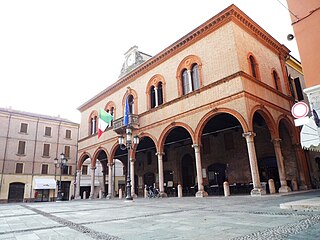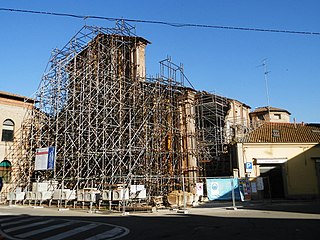
Giovanni Ambrogio Figino was an Italian Renaissance painter from Milan.

Mirandola is a city and comune of Emilia-Romagna, Italy, in the Province of Modena, 31 kilometres (19 mi) northeast of the provincial capital by railway.

Museo di Capodimonte is an art museum located in the Palace of Capodimonte, a grand Bourbon palazzo in Naples, Italy. The museum is the prime repository of Neapolitan painting and decorative art, with several important works from other Italian schools of painting, and some important ancient Roman sculptures. It is one of the largest museums in Italy. The museum was inaugurated in 1957.

The Museo Civico d'Arte Antica is an art museum located in the Palazzo Madama in Turin, Italy. It has a renowned collection of paintings from the medieval, Renaissance and Baroque periods. It reopened in 2006 after several years of restorations.

The following is an alphabetical list of articles related to Italy.

The Museo Nazionale della Magna Grecia, Museo Archeologico Nazionale di Reggio Calabria or Palazzo Piacentini is a museum in Reggio Calabria, southern Italy, housing an archaeological collection from sites in Magna Graecia.

The Galleria Estense is an art gallery in the heart of Modena, centred around the collection of the d’Este family: rulers of Modena, Ferrara and Reggio from 1289 to 1796. Located on the top floor of the Palazzo dei Musei, on the St. Augustine square, the museum showcases a vast array of works ranging from fresco and oil painting to marble, polychrome and terracotta sculpture; musical instruments; numismatics; curios and decorative antiques.

Daniele Ranzoni was an Italian painter of second half of the 19th century.
Alessandro Scorzoni was an Italian painter, who depicted eclectic subjects, including sacred images, allegorical paintings, portraits, and landscapes.

The Civic Museum of Crema is an Italian museum, located in Crema.

The Museo Civico Filangieri is an eclectic collection of artworks, coins, and books assembled in the nineteenth century by Gaetano Filangieri, prince of Satriano, who gave it to the city of Naples as a museum. It is housed in his former palace, Palazzo Cuomo on Via Duomo, by the church of San Severo al Pendino.

The Casino Mediceo di San Marco is a late-Renaissance or Mannerist style palace located on Via Cavour number 57 and via San Gallo in Florence, region of Tuscany, Italy.
Museo Civico may refer to:
The Gallerie Estensi is a network of three museums and a library, bringing together the collective fruits of artistic production from Ferrara, Modena and Sassuolo in the Emilia-Romagna region of Northern Italy. The galleries aim to preserve the historic heritage left by the influential House of Este, with a focus on relating their noble past to the local communities at each site.

The Castle of the Pico is a castle in the city center of Mirandola, in the province of Modena, Italy.

The Town hall of Mirandola is a historic public building located in the city center of Mirandola, in the province of Modena, Italy.

The church of San Francesco is a church located in Mirandola, in the province of Modena, Italy.

The Mirandola mint, also known as the mint of the Pico della Mirandola, was the mint of the Duchy of Mirandola.

Giuseppe Graziosi was an Italian sculptor, painter and graphic designer.


























